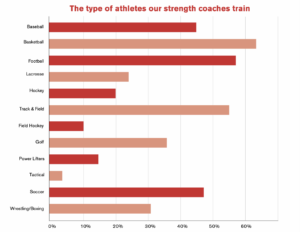Oct 19, 20222022 Strength Coaches Survey Results
Strength and conditioning coaches have two primary goals. The first is to improve athletic performance, which usually means improving athletes’ speed, strength, and power through systematic training programs for both teams and individual athletes, often working in close association with coaches.
The second primary goal is to reduce athletic injuries. To that end, strength coaches design regimens to strengthen body parts that are prone to injury in a particular sport.
Building strength, power, and speed while keeping actively participating in injury prevention and rehabilitation in athletes — that’s the name of the game for strength coaches. And that sort of transformative development has taken shape in the industry overall. According to the U.S. Bureau of Labor Statistics, the health and fitness trainer industry is expected to see a 12 percent growth through 2029 and produce roughly 30,000 jobs.
Training & Conditioning Magazine asked strength and conditioning specialists across the country to partake in a survey on what’s affecting their industry currently, the injuries they see, and the important principles of strength training.

Biggest Industry Challenges
Dealing with social media fads and trends, countering training misinformation, and getting long-term buy-in from clients — are just a few of the challenges strength coaches said they face regularly.
“Internet experts and a pendulum that swings from Crossfit and Tactical Training to Olympic Lifting (which is a sport, not a training method) for everyone, to ‘functional training’ without ever getting stronger or more powerful,” one strength coach said.
Another added, that “providing accurate information and combating ineffective trendy information” is the biggest problem strength coaches face today.
More than trendy misinformation, many strength coaches lamented the lack of buy-in from clients which often limits results and renders their work meaningless.
“So many quit before the finish line,” one strength coach said.
“Consistency is key. Getting clients to realize that is difficult,” another coach said. “Also it’s about conveying the two goals of strength and conditioning: building injury resilience first and then performance.”
 While some expressed frustration in getting buy-in from their clients, others had difficulty getting buy-in from their sport coaches.
While some expressed frustration in getting buy-in from their clients, others had difficulty getting buy-in from their sport coaches.
“Dealing with coaches that have no idea about exercise science — how the body adapts, proper training progressions, and recovery. Not realizing that strength training, plyos, speed, agility, speed endurance, and practice need to use periodization and work together for optimal performance,” one coach said. “At the high school level — overtraining multi-sport athletes — everyone practices all sports year round with no regard to what the other coach(es) are doing.”
Strength Training Principles
Injury prevention was the major response from strength coaches when answering the survey on the most important training principles to instill in their athletes. And to prevent injuries, developing a solid understanding of the performed exercises and sound form is necessary.
According to one strength coach, “avoiding injury should be a priority. Rest, recovery, and recuperation can be as important as training, if not more so. Patience—increases in strength take time.”
And that coach wasn’t alone in that type of thinking. Many responded first with some sort of injury prevention tactic or foundational piece before advancing their responses.
“Rest and recovery. Without it, you’re just spinning your wheels,” one strength coach said.
Another added that the most important principle is the technical side of strength training. “Getting them to understand the why and how is crucial. There is not enough education for the athlete,” they continued.
 A different strength coach mentioned Davis’ Law, which is training athletes in a variety of directions, at different speeds and with different loads to protect the body and make the connective tissue stronger.
A different strength coach mentioned Davis’ Law, which is training athletes in a variety of directions, at different speeds and with different loads to protect the body and make the connective tissue stronger.
“Variability is specificity,” they added.
“Build a strong core as part of your warm-up. Ensure that the shoulder and hip have the requisite AROM under control. Program progressions that are relevant to ensuring ‘laws’ 1 and 2 are maintained while getting stronger,” another coach offered up in the survey.
Overlooked Aspects of Strength Coaching
From proper breathing to mobility to recovery efforts, depending on who you ask about overlooked aspects of strength training the answer is different every time.
Below is a sampling of some of the responses we received from the survey.
“We overlook how to create a balance of strength and power training in three dimensions. The industry focuses too much on prioritizing lifting in the sagittal plane and vertical direction.”
“Strength training shouldn’t be undertaken only by serious athletes. Strength training is important for fitness and overall health for EVERYONE.”
“Using strength training to PREVENT injuries, not just to get strong.”
“Eccentric patterns and central nervous system adaptation.”
“Just more reps on basics instead of trying to make it on Instagram.”



